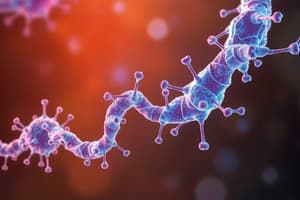Podcast
Questions and Answers
What is the primary function of Autogenic Inhibition?
What is the primary function of Autogenic Inhibition?
- To protect muscles from exerting more force than bones and tendons can tolerate (correct)
- To enhance proprioception during muscle contraction
- To facilitate muscle relaxation during stretching exercises
- To increase muscle force beyond the tolerance of bones and tendons
Which receptors are responsible for Autogenic Inhibition?
Which receptors are responsible for Autogenic Inhibition?
- Tendon Receptors
- Free Nerve Endings
- Golgi Tendon Organs (GTO) (correct)
- Muscle Spindles
What happens to the antagonist muscle during Reciprocal Inhibition?
What happens to the antagonist muscle during Reciprocal Inhibition?
- It relaxes as the agonist muscle contracts (correct)
- It contracts simultaneously with the agonist muscle
- It remains unaffected by the agonist muscle's contraction
- It stretches further to facilitate proprioception
What is the purpose of the Stretch Reflex?
What is the purpose of the Stretch Reflex?
What is the result of Autogenic Inhibition on muscle contraction?
What is the result of Autogenic Inhibition on muscle contraction?
Where are Muscle Spindles located?
Where are Muscle Spindles located?
What is the primary mechanism by which Reciprocal Inhibition reduces pain perception?
What is the primary mechanism by which Reciprocal Inhibition reduces pain perception?
What is the main purpose of Post Isometric Relaxation (PIR) technique?
What is the main purpose of Post Isometric Relaxation (PIR) technique?
What is the concept behind Autogenic Inhibition MET?
What is the concept behind Autogenic Inhibition MET?
What is the role of rhythmic muscle contractions in Reciprocal Inhibition?
What is the role of rhythmic muscle contractions in Reciprocal Inhibition?
What is the result of increased flexibility in individual's tolerance to stretch?
What is the result of increased flexibility in individual's tolerance to stretch?
What is the purpose of asking the patient to inhale during the isometric contraction in PIR technique?
What is the purpose of asking the patient to inhale during the isometric contraction in PIR technique?
What is a contraindication for applying the Muscle Energy Technique (MET)?
What is a contraindication for applying the Muscle Energy Technique (MET)?
What is an error that a therapist can make when applying the MET?
What is an error that a therapist can make when applying the MET?
What is the consequence of not waiting for the refractory period following an isometric contraction?
What is the consequence of not waiting for the refractory period following an isometric contraction?
What is an error that a patient can make when applying the MET?
What is an error that a patient can make when applying the MET?
What is the definition of Integrated Neuromuscular Inhibition Technique (INIT)?
What is the definition of Integrated Neuromuscular Inhibition Technique (INIT)?
Why does Chaitow believe that the combination of MET, ischemic compression, and SCS produces the most effective approach to trigger point release?
Why does Chaitow believe that the combination of MET, ischemic compression, and SCS produces the most effective approach to trigger point release?
Flashcards are hidden until you start studying
Study Notes
Autogenic Inhibition
- A sub-maximal contraction of a muscle is followed by stretching of the same muscle, resulting in sudden relaxation.
- Golgi tendon organs (GTO) are responsible for autogenic inhibition, sensing increased tension when the muscle contracts or stretches.
- GTO sends sensory fibers to the spinal cord, synapsing on inhibitory interneurons, which inhibit the contraction and help muscle elongation.
- Autogenic inhibition is a protective mechanism, preventing muscles from exerting more force than bones and tendons can tolerate.
Reciprocal Inhibition
- A sub-maximal contraction of a muscle is followed by stretching of the opposite muscle, known as reciprocal inhibition.
- Muscle spindles are responsible for reciprocal inhibition, located within the muscle and stretching alongside with it.
- When the muscle contracts, the central nervous system sends a message to the agonist muscle to contract, causing reflexive contraction in the agonist's muscle and relaxation in the antagonist muscle.
Physiological Effect
- Increases flexibility of the muscles, attributed to an increase in individual’s tolerance to stretch.
- Reduces pain perception (hypoalgesia) through the activation of muscles’ and joints’ mechanoreceptors.
- Induces hypoalgesia via peripheral mechanisms associated with increasing fluid drainage, leading to decreased sensitization to peripheral nociceptors.
- Improves proprioception and motor control due to active and precise recruitment of muscle activity.
Types of Muscle Energy Technique
- Autogenic Inhibition MET
- Post Isometric Relaxation (PIR)
- Post Facilitation Stretching (PFS)
- Reciprocal Inhibition MET
- Post Isometric Relaxation (PIR)
Post Isometric Relaxation (PIR)
- A technique to decrease muscle tone in a single or group of muscles, after a brief period of submaximal isometric contraction of the same muscle.
- Works on the concept of autogenic inhibition.
- Performed by taking the hypertonic muscle to a length where resistance to movement is first noted, followed by a submaximal contraction and application of resistance in the opposite direction.
- After contraction, the patient is asked to relax and exhale.
Contraindications and Precautions
- Contraindications: fracture, acute sprains, acute strains
- Precautions: osteoporosis, hypermobility, acute pain, vertebrobasilar insufficiency
Errors in Applying MET
- Therapist errors: inaccurate control of joint position, incorrect direction of counterforce, inadequate patient instructions, moving to a new joint position too soon, not waiting for refractory period, and not maintaining stretch position for an appropriate period of time.
- Patient errors: contraction is too hard, contraction is in the wrong direction, contraction is not sustained for long enough, individual doesn’t relax completely after contraction, and starting or finishing contraction too fast.
Integrated Neuromuscular Inhibition Technique (INIT)
- A manual technique combining ischemic compression, strain counter strain, and muscle energy techniques.
- Described by Chaitow (2010) as the most effective, targeted approach to trigger point release.
Studying That Suits You
Use AI to generate personalized quizzes and flashcards to suit your learning preferences.




